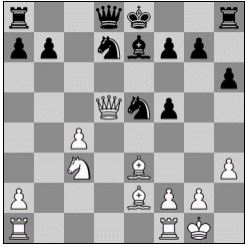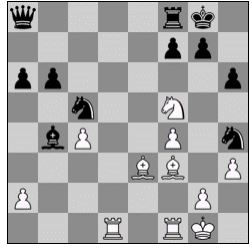For all the beauty and excitement of the games highlighted so far in our coverage of the 84th Mass Open, perhaps the most important game of the tournament was the third round battle which pitted the top two seeds in the highest section against one another. After claiming victory here, then 20-time Mass Open champion Ivanov cruised through his remaining matches, taking two draws and a win to claim the trophy outright.
GM Alexander Ivanov (2621)
IM David Vigorito (2508)
84th Massachusetts Open (3)
05.24.2015
QGD – Slav (D12)
1. e4 c6 2. d4 d5 3. e5 Bf5 4. Nf3 e6 5. Be2 Nd7
5... c5 leads to sharper lines, for example 6. Be3 Qb6 7. Nc3 etc; 5... Ne7 is another common move order.
6. 0-0 h6
6... Ne7
7. b3
One of the most popular tries in this position. White wants to play c4 and recapture with a Pawn in case of dxc4. Statistically only 7. Nbd2 has been played more often.
7... Ne7 8. c4
8. Ba3 Ng6 9. Bxf8 Ngxf8 won't stop Black from castling short eventually.
8... Ng6 9. Be3
The immediate 9. h3 deserves attention. Also known is 9. Na3 Nf4!? 10. Bxf4 Bxa3 11. Bd3 Bg4 12. Rb1 Be7 13. h3 Bh5 14. Qe2 0-0 15. Qe3 Bg6!=, which happened in a number of games.
9. Nc3?! Bb4 10. Bd2 Nf4!?
9... Be7 10. h3? dxc4?!
This move followed by c5 practically forces White to sacrifice a pawn. On the other hand, the position opens up and White's two Bishops give him an excellent compensation.
10... 0-0 11. Nc3 f6 was probably better.
11. bxc4 c5 12. Nc3 cxd4 13. Nxd4 Ngxe5 14. Nxf5 exf5 15. Qd5!

As the rest of the game illustrates, Black underestimated this powerful centralising move. Now White is better, as the threat of Rd1 followed by f4 is not easy to repel.
15... 0-0 16. Rad1 Bb4
16... Bf6 17. f4!? Nc6 18. Qxf5 Bxc3 19. Rxd7²
17. Nb5 a6
17... Qe7!?
18. Nd6?!
I spent a lot of time here leaving just 12 minutes on the clock. 18. a3?! was my intention at first, but then I found Black's 20th move in the following line: 18... axb5 19. axb4 bxc4 20. f4 Nd3! 21. Bxd3 (21. Qxc4? Nb2!µ) 21... cxd3 22. Rxd3 Nf6 23. Qxf5 Qc8=.
Perhaps 18. Nd4!? was more accurate, not allowing Black to capture the Knight since 18... g6 (18... Qf6? 19. f4!±; 18... Qc7!? 19. Nxf5²) fails after 19. Nc2!+- planning a subsequent f4.
18... b6?!
18... Bxd6 19. Qxd6 Re8!∞ 20. f4 Nc6 21. Qxd7 Qxd7 22. Rxd7 Rxe3 23. Bf3 Nd8=
19. f4
Even stronger is the computer idea which was beyond me: 19. c5! bxc5 (19... Bxc5 20. Bxc5 bxc5 21. f4 Ng6 22. Nxf7! Rxf7 23. Bc4+-; 19... f4 20. Bxf4 Qf6 21. Bg3 bxc5±) 20. f4 Ng6 21. Nxf7! Rxf7 22. Bc4±
19... Ng6 20. Nxf5² Nc5 21. Bf3
21. Bh5!±
21... Nh4?
Missing White's zwischenzug on move 23. Though after 21... Rb8 22. g3 White is clearly better.
22. Qxa8 Qxa8

23. Ne7+
Black was counting on 23. Bxa8? Nxf5µ and White can't save one of his hanging Bishops since on 24. Bc5 Black will recapture with a check. After the text Black loses the exchange with a b6 pawn advance soon to follow, so he chose to resign immediately.
1-0 |